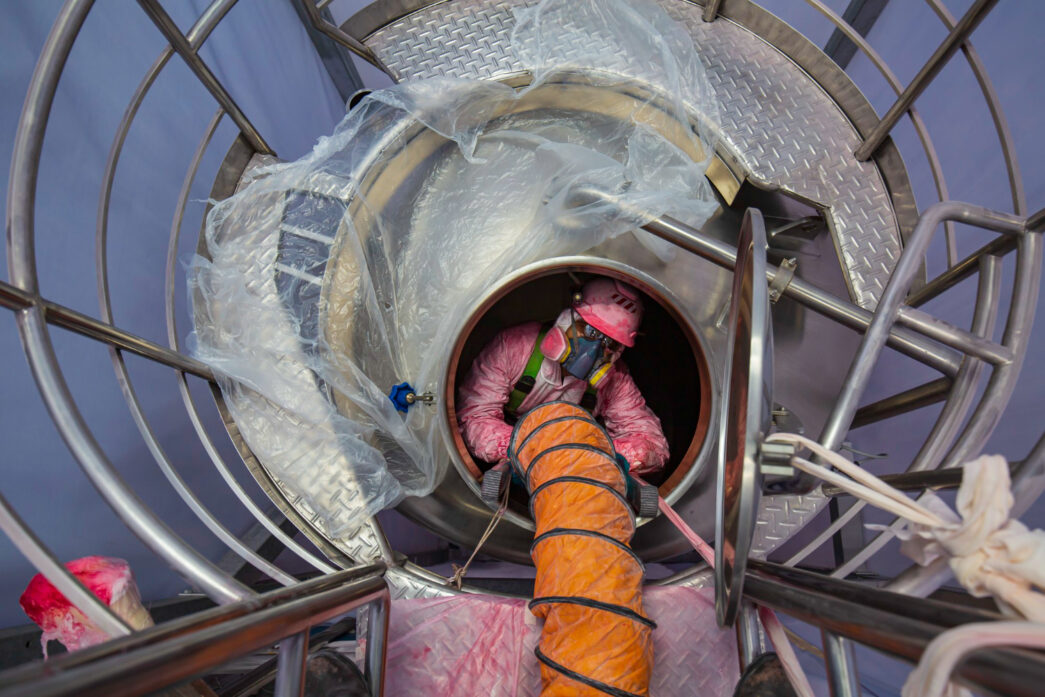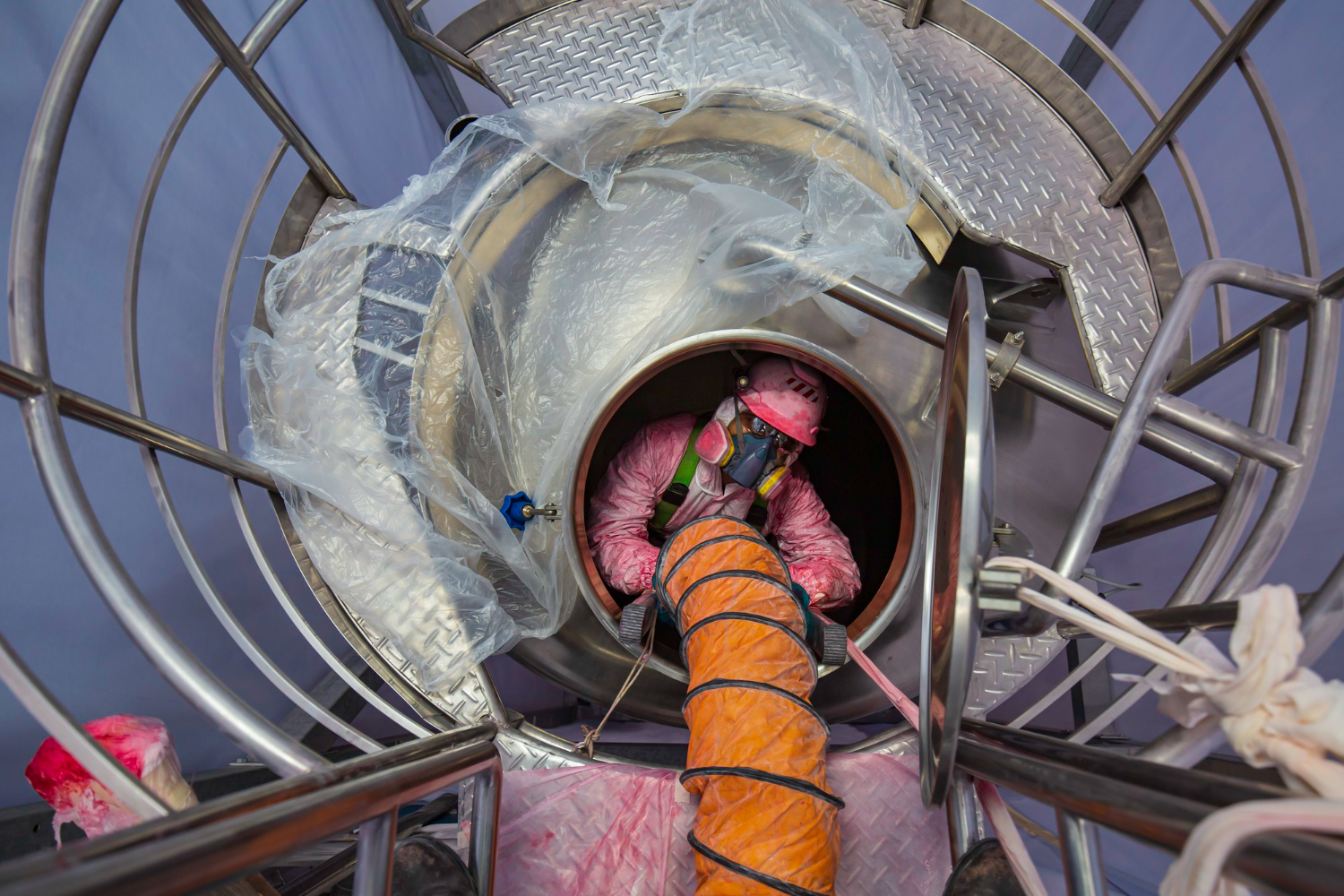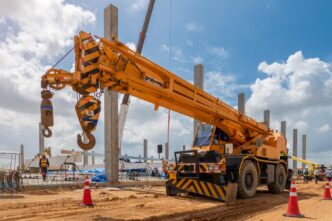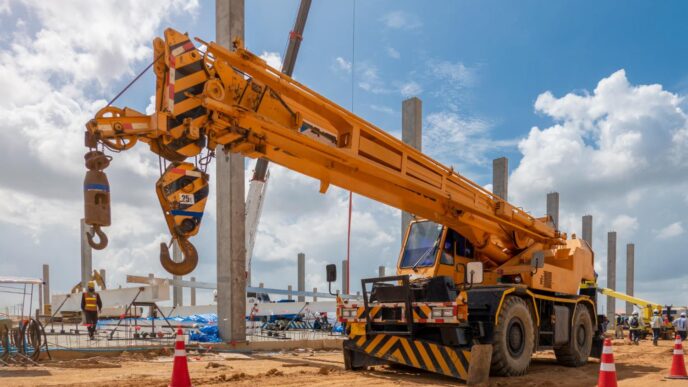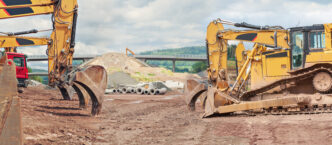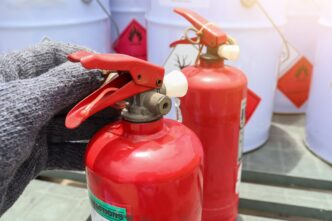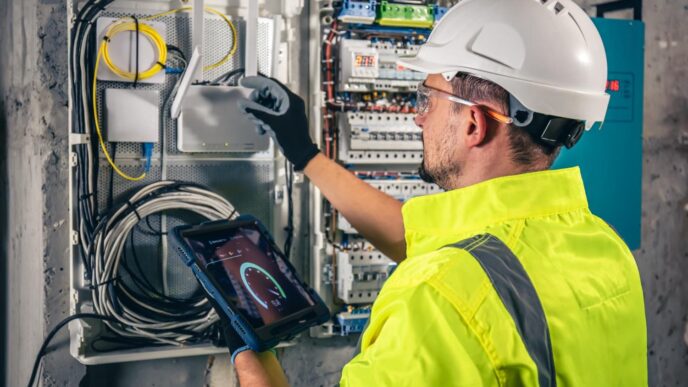Nome Técnico: NR 33 TRAINING COURSE – OCCUPATIONAL SAFETY AND HEALTH IN CONFINED SPACES – AUTHORIZED WORKER AND WATCHMAN LEVEL – TAUGHT IN ENGLISH
Reference: 10755
We provide Courses and Training; we perform Technical Language Translations and Interpretations: Portuguese, English, Spanish, Mandarin, German, Hindi, Japanese, Arabic and others.
What is the objective of the NR 33 Course – Authorized Worker and Watchman?
The objective of the NR 33 Course – Authorized Worker and Watchman is to technically train professionals to operate safely, responsibly, and in full legal compliance within confined spaces, as required by NR 33. The content prepares both the authorized worker and the watchman to identify atmospheric, physical, and organizational risks, interpret the Entry and Work Permit (PET), properly use safety equipment, and act in a coordinated manner during emergency situations.
Moreover, this course goes beyond simply complying with a regulation, it invites participants to embrace a new level of awareness: to understand that their presence, focus, and internal state directly influence the safety of the operation. Therefore, safety is not just about regulation, it is a state of being.
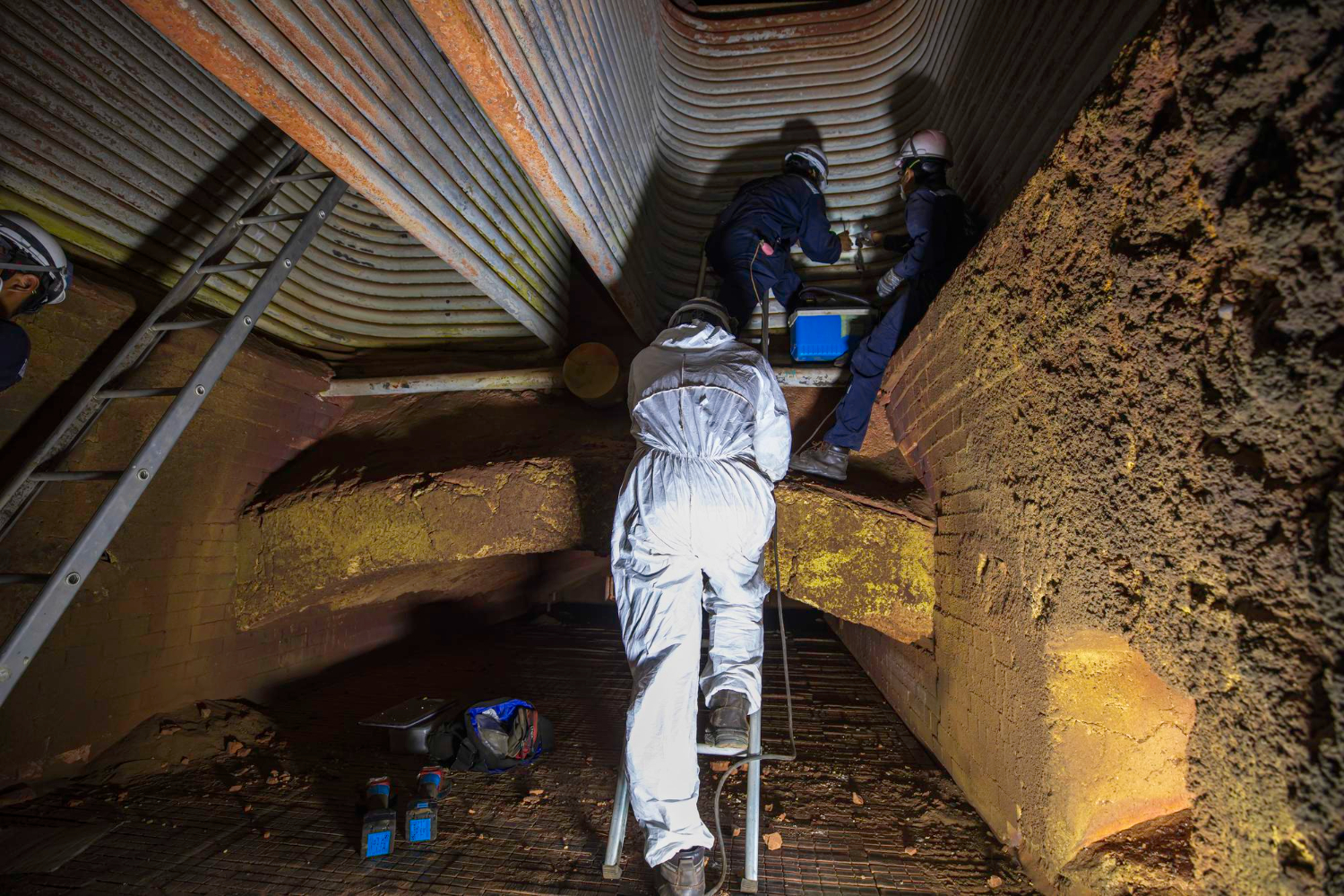
What is the difference between the roles of the authorized worker and the watchman according to NR 33, during confined space entry?
The authorized worker is someone formally trained and cleared to enter the confined space, perform specific tasks, and use the necessary equipment with responsibility and competence. The watchman remains outside the space, maintaining constant visual or communicative contact, monitoring time spent inside, controlling access, and activating the emergency plan if needed.
In practice, the authorized worker brings the body into the risk zone; the watchman sustains the link between external safety and immediate response. Both are complementary components of the same operational field, one acts, the other safeguards. This synergy only works when mutual respect, trust, and coherence are present.
What are the minimum criteria that must be included in the Entry and Work Permit (PET) before starting confined space activities?
The PET must include:
Identification of the confined space and activity;
Names of the authorized workers and the watchman;
Start and end date and time;
Identified risks and applied control measures;
Available emergency equipment;
Responsible technical personnel;
Defined rescue plan;
Signed authorizations.
Although formal, this document carries technical and ethical weight. It is a contract of trust between life, regulation, and those involved. When filled out with awareness rather than as a formality, it becomes a vibrational shield against negligence.
What equipment is mandatory for continuous atmospheric monitoring in confined spaces?
According to NR 33, multi-gas detectors are required to monitor:
Oxygen deficiency or excess (O₂);
Flammable gases (LEL – Lower Explosive Limit);
Toxic gases such as carbon monoxide (CO) and hydrogen sulfide (H₂S).
These detectors must be calibrated and capable of continuous reading. In some cases, ventilators/exhaust systems, directional ducts, and backup power may be required.
However, the most powerful sensor remains the worker’s active perception: a truly present operator senses the environment beyond the data — they detect subtle changes, recognize patterns, and anticipate danger.
How should the watchman record and document occurrences during confined space operations?
The watchman must document, with accuracy and continuity, all data related to the entry, stay, and exit of workers, including:
Entry and exit times;
Changes in atmospheric conditions;
Communication failures;
Interruptions;
Behavioral or technical observations;
Emergency activations (if applicable).
These records should be made using standardized documents and may be incorporated into reports or audits. What distinguishes an ordinary watchman from an elevated professional is their level of presence. They don’t just write – they bear witness to the environment.
How can your internal state influence your focus and decision-making as a watchman during a critical event?
The watchman’s internal state directly affects their response capacity. An agitated mind may overlook subtle signals; an unbalanced emotional field can block intuition and slow reaction time. In critical situations, seconds matter.
When the watchman breathes consciously, maintains focus, and aligns their intent with collective safety, they enter a state of coherence. This enhances their ability to detect what the eyes miss — behavioral patterns, slight procedural deviations, or emotional shifts in the authorized worker. The body may be present, but it is the energetic field that truly sustains the role.
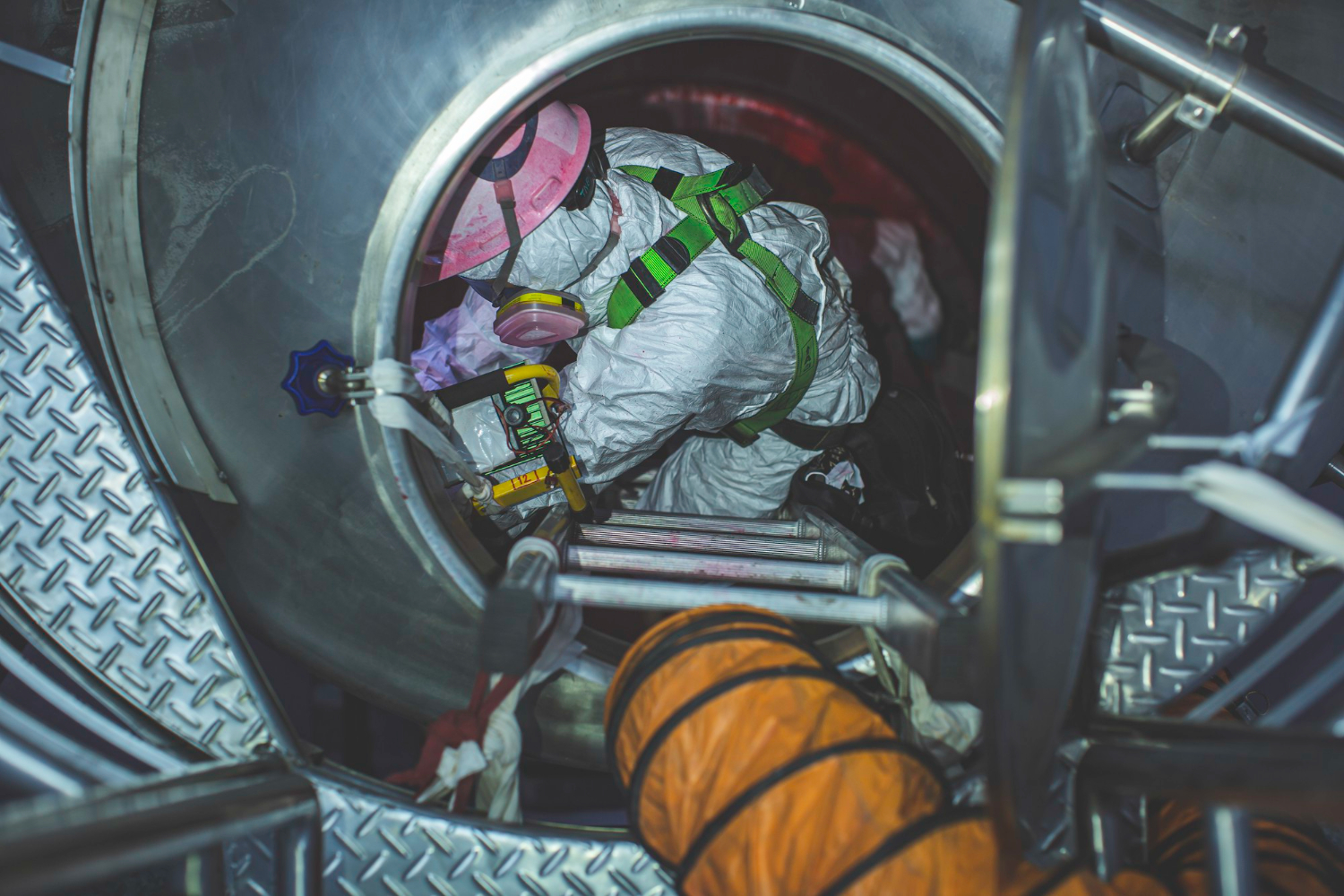
When the rescue plan fails, is it just an operational failure or a reflection of misalignment between team, environment, and intention?
When a rescue plan fails, the issue rarely lies solely on paper. It often stems from a lack of rehearsals, role clarity, or the team’s disconnection from the true purpose of the operation: to protect life. A signature on a PET without presence and accountability is just ink on paper. Where there is automatism, there are gaps.
A rescue plan can only hold if there is synergy among those who execute, supervise, and respond. It must be alive, rehearsed, revisited, and deeply understood. When everyone involved recognizes they are operating at the threshold between life and death, the plan transcends documentation, it becomes a vibrational pact, forged in technical skill, attention, and aligned intention.
If equipment were calibrated with the same level of care you give your PPE, would it save lives or put them at risk?
The care you give to your PPE reflects your level of awareness. A dirty helmet, a loose harness, or a neglected mask signal a negligent relationship with your body and, by extension, with life itself. This silent negligence echoes in the environment: if you mistreat what protects you, why would you treat the rest any better?
Measurement, ventilation, and gas detection equipment demand precision, yes, but more than that, they require energetic respect. Proper calibration begins in the mind of the operator. True safety doesn’t originate from regulations; it arises from coherence between what is preached and what is practiced, between what is worn and what is embodied. And it all begins with the smallest detail: how you care for your own PPE.
See Also:
NR 33 Course in Spanish
NR 33 Course Taught in German
Classification of Confined Spaces: Disturbed and Non-Disturbed
Treinamento Livre Profissionalizante Noções Básicas (Não substitui Formação Acadêmica ou Ensino Técnico)
Certificado de conclusão
Authorized Confined Space and Watchman NR 33 course in English
Module 1 – (3 hours)
I. Definitions
Module 2 – (4 hours)
II. Hazard recognition, assessment, and control
Module 3 – (3 hours)
III. Operation of equipment used in confined spaces
Module 4 – (3 hours)
IV. Procedures and use of the Entry Permit (PET)
Module 5 – (3 hours)
V. Basic rescue and first aid concepts
Practical Exercises:
– Evidence Recording
– Theoretical Evaluation
– Practical Evaluation (When contracted)
– Certificate of Participation
Observation:
The syllabus of this course complies with the guidelines established by Regulatory Standard NR 33, ensuring proper training for workers performing activities in confined spaces.
Note:
We emphasize that the General Normative Training Syllabus may be modified, updated, or have items added or removed as deemed necessary by our Multidisciplinary Team.
Our Multidisciplinary Team is authorized to update, adapt, modify, and/or exclude content, including the inclusion or exclusion of Standards, Laws, Decrees, or technical parameters they deem applicable—whether directly related or not. The contracting party is responsible for ensuring compliance with applicable legislation.
Authorized Confined Space and Watchman NR 33 course in English
Authorized Confined Space and Watchman NR 33 course in English
Participants without experience:
Minimum working load = 40 hours / class
Participants with experience (Authorized and Watcher Level):
Minimum working load = 16 hours / class
Update (Recycle – Authorized and Watcher Level):
Minimum working load = 08 hours / class
Update (Recycle): NR-33 Item 33.3.5.3: All authorized workers, Watchers and Entry Supervisors must receive periodic training every 12 months, with a minimum working load of 8 hours. (Amended by Ministerial Order No. 1,409, of August 29, 2012).
NR-33 Item 3.5.2: The employer shall develop and implement training programs whenever any of the following situations occur:
a) change in procedures, conditions or work operations;
b) some event that indicates the need for new training; and
(c) where there is a reason to believe that there are deviations in use or entry procedures in confined spaces or that knowledge is inadequate.
Authorized Confined Space and Watchman NR 33 course in English
Authorized Confined Space and Watchman NR 33 course in English
Regulatory References to Applicable Provisions and Their Updates:
NR 01 – Disposições Gerais e Gerenciamento de Riscos Ocupacionais;
NR 33 – Segurança e Saúde nos Trabalhos em Espaços Confinados;
ABNT NBR 16577 – Espaço confinado – Prevenção de acidentes, procedimentos e medidas de proteção;
Protocolo – Guidelines American Heart Association;
ISO 10015 – Gestão da qualidade – Diretrizes para treinamento;
ISO 45001 – Sistemas de gestão de saúde e segurança ocupacional – Requisitos com orientação para uso;
Note: This service exclusively meets the requirements of the Special Secretariat for Social Security and Labor (SEPRT); if the service is intended to comply with other agencies, please inform us at the time of the request.
Authorized Confined Space and Watchman NR 33 course in English
Authorized Confined Space and Watchman NR 33 course in English
Our pedagogical project follows the guidelines imposed by Regulatory Standard #1.
After effective payment, Purchase Order, Contract signed between the parties, or other form of closing confirmation, the didactic material will be released within 72 working hours (up to 9 days), due to the adaptation of the programmatic content and adaptation to the Technical Standards applicable to the scenario expressed by the Contractor; as well as other adaptations to the didactic material, carried out by our Multidisciplinary Team for technical language according to the student’s nationality and Technical Operational and Maintenance Instruction Manuals specific to the activities that will be performed.
Attention: The course teaches how to apply the normative concepts of the standard, which enables one to sign Projects, Reports, Expert Reports, etc. are the attributions that the Legally Qualified Professional has with his Class Council, for example CREA.
This course aims to study situations where it will be necessary to apply: Concepts and Calculations according to pertinent Standards and does not replace the analysis and responsibility on the part of each professional accredited with CREA or other Class Councils in the most varied situations, where it becomes absolutely necessary to respect the conditions of conservation of the equipment, periodic gauging of the instruments, such as the respect of primary capacity pre-determined by the manufacturers of PPE’s, among others based on the corresponding Standards.
Certificate: A Certificate will be issued to each participant who achieves a minimum of 70% (theoretical and practical) as recommended by the Regulatory Norms.
Criteria for Training or Updating Certificates:
Our certificates are numbered and issued in accordance with the Regulatory Standards and applicable devices:
Issuance of the A.R.T. (Notation of Technical Responsibility);
Full name of the employee and identity document;
Programmatic content;
Workload; City, place and date when the training took place;
Name, identification, signature and qualification of the instructor(s);
Name, identification, signature and qualification of the technical responsible for the training
Name and qualification of our Qualified Professional;
Specification of the type of work;
Space for signature of the trainee;
Information in the Certificate that the participants received an e-book containing didactic material (Apostille, Videos, Standards, etc.) presented in the training.
Evidence of Training: Edited video, photos, scanned documentation, continuous improvement, instructor’s opinion: Consult values.
Warning:
EAD (Distance Learning), Semi-Presential The EAD Certificate also known as Online, according to LAW No. 9.394, OF DECEMBER 20, 1996. can be used for Complementary Activities; Company Evaluations; Public Contests; University Extension; Extracurricular Hours; Improved chances of obtaining employment; Recruitment processes; Internal promotions; Title exams; Doctoral selections; Master’s selections; Among other opportunities. Course 100% EAD (Distance Learning ) or Semipresential needs Pedagogical Project is only valid for the Employer, if it fully follows the SEPRT Ordinance No. 915, July 30, 2019 – NR 01 – General Provisions of the Special Secretary of Welfare and Labor. Click here!
OTHER ELEMENTS WHEN APPLICABLE AND CONTRACTED:
Definitions;
Recognition, evaluation and control of risks;
Control measures;
Physical risks;
Chemical risks;
Biological risks;
Ergonomic risks;
Risks of accidents;
Identification of confined spaces;
Operation of equipment used in Confined Spaces;
Breath protection;
Procedures and use of the Entry and Work Permit;
The forms of communication between the team, lookouts and rescue group;
Concepts and practices on safety equipment;
Types of safety equipment (PPE and EPC);
Operation of safety equipment;
Inspection of equipment and safety items;
Criteria for indicating and using equipment for risk control;
Operation of equipment used in Confined Spaces;
Procedures and use of Entry and Work Permit in confined spaces;
Accident Prevention, Notions of First Aid + DEA;
Complements of the Activity:
Importance Awareness:
APR (Preliminary Risk Analysis);
PAE (Emergency Action Plan;
PGR (Risk Management Plan);
Understanding the Need for the Rescue Team;
The Importance of task knowledge;
Accident prevention and first aid notions;
Protection against fires;
Risk perception and factors affecting people’s perceptions;
Impact and behavioral factors in safety;
Fear factor;
How to discover the fastest and easiest way to develop skills;
How to control your mind while working
How to administer and manage work time;
Why balance energy during activity for productivity
Consequences of Risk Habituation;
Causes of accidents at work;
Notions on the Tree of Causes;
Notions on Fault Tree;
Understanding Ergonomics;
Analysis of Workplace;
Ergonomic Risks;
Hazard Communication Standard (HCS) – OSHA;
Practical Exercises:
Evidence Recording;
Theoretical and Practical Evaluation;
Certificate of Participation.
Authorized Confined Space and Watchman NR 33 course in English
Know More: Authorized Confined Space and Watchman NR 33 course in English
33.3.5.3 All authorized workers, Watchers and Entry Supervisors must receive periodic training every 12 months, with a minimum working load of 8 hours. (Amended by Ministerial Order No. 1,409, of August 29, 2012).
33.3.5.2 The employer shall develop and implement training programs whenever any of the following situations occur:
A) change in procedures, conditions or work operations;
B) some event that indicates the need for new training; And
C) where there is a reason to believe that there are deviations in use or entry procedures in confined spaces or that knowledge is not adequate.
33.3.5.4 The initial training of authorized workers and Watchers must have a minimum workload of sixteen hours, be carried out within working hours, with programmatic content of: (Amended by Administrative Rule MOP no. 1,409, of August 29, 2012) .
A) definitions;
B) recognition, evaluation and control of risks;
C) operation of equipment used;
D) procedures and use of the Entry and Work Permit; And
E) notions of rescue and first aid.
33.3.5.1 The designation for work in confined spaces is prohibited without the prior qualification of the worker.
33.4.2 Personnel responsible for the execution of rescue measures shall be physically and mentally compatible with the activity to be performed.
33.4.3 The training of the rescue team shall include all possible accident scenarios identified in the risk analysis.
33.5 General Provisions
33.5.1 The employer shall ensure that workers are able to interrupt their activities and leave the workplace whenever they suspect that there is a serious and imminent risk to their safety and health or to a third party worker.
33.5.2 The contracting company and the contractor company shall be jointly and severally liable for compliance of this NR.
33.5.3 It is forbidden to enter and perform any work in confined spaces without the issue of the Entry and Work Permit.
F: NR 33
01 – URL FOTO: Licensor’s author: noomcpk – Freepik.com
02 – URL FOTO: Licensor’s author: noomcpk – Freepik.com
03 – URL FOTO: Licensor’s author: noomcpk – Freepik.com
Authorized Confined Space and Watchman NR 33 course in English: Contact us.

